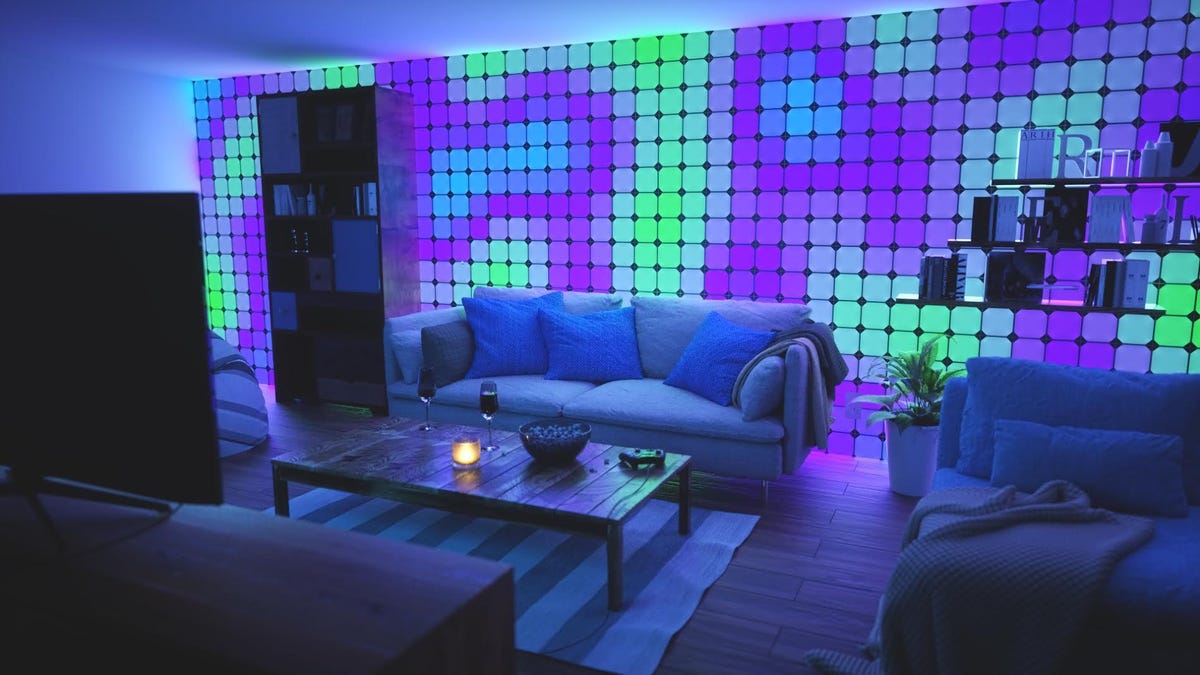Nanoleaf wants to cover your walls in color-changing light
Nanoleaf's color-changing light panels were a game changer for the company. Now, at CES 2018, the company's turning the idea up to 11.

Nanoleaf began as a little LED lighting startup selling odd-looking light bulbs and smart bulbs, but those bulbs have since taken a backseat to the company's color-changing Aurora light panels. Connect them in any configuration you like and stick them to your wall, then enjoy the light show as they change colors, sync with Alexa, Siri, and the Google Assistant, and sync with your music, too.
Nanoleaf claims that the triangular color-changers, now known simply as Nanoleaf Light Panels, were hot sellers in 2017, selling out at their Museum of Modern Art retail launch and selling out within hours during a Black Friday sale at Best Buy. After just over a year on the market, Nanoleaf founder and CEO Gimmy Chu tells me that the company's light panels now account for roughly 75 percent of its revenue. Meanwhile, competitors like Lifx are starting to take notice and jump in with color-changing panels of their own.
Boy, the voice-activated, color-changing LED wall really ties the room together.
Now, at CES 2018, Nanoleaf is ready to double down on the idea, and that means more panels -- a lot more panels. Specifically, Nanoleaf is introducing a new square-shaped variation of its light panels, and while pricing and even the official product name are still to be determined, it sounds like they'll come with a couple of compelling improvements.
For starters, each individual panel will be touch sensitive, allowing you to turn them on and off, dim them up and down, or change their color just by tapping on them. The base station will also come embedded with its own music sync microphone and motion sensor capable of lighting the panels up whenever you walk by. Chu says that Nanoleaf plans to open up the software for all of it to outside developers, an approach that's already led to things like third-party apps capable of simulating a thunderstorm on the panels, or a crackling fire.
The biggest upgrade might be scalability. Before, you could connect up to thirty of the triangular panels to a single base station. With the new square panels, that number is one thousand (although Nanoleaf points out that you'll need to connect additional power boosters for every sixty panels to maintain optimal brightness).
That means that, should you choose, you could literally cover your walls with these things (and judging by Nanoleaf's concept shots, that seems to be the idea). How much a gargantuan setup like that would cost remains to be seen, but Chu tells me that his plan is to keep the square panels as affordable as possible.
Another Nanoleaf spokesperson adds that the goal is "to make the new product as accessible as the original kit." That original, nine-panel kit currently sells in a bundle with the base station and the music-syncing rhythm module for $230. The idea of matching that price while adding in touch controls and improved efficiency seems awfully ambitious to me -- if Nanoleaf can even land in the ballpark, I'll be impressed.
The bigger play might be places like nightclubs and concert halls looking to set a high-tech ambiance. Nanoleaf already has one such partnership in the works with Rebel, a popular nightclub in Toronto, home of Nanoleaf's headquarters. The "rhythm installation" is slated to launch by the end of this month, then serve as a long-term means of showcasing the company's new and upcoming products.
"These are the kinds of spaces that scream potential to us," the Nanoleaf spokesperson told me.
Nanoleaf's dodecahedron-shaped remote is ready for release, and it can trigger HomeKit scenes.
A new remote, too
Also new at CES 2018: a long-awaited dodecahedron-shaped controller for Nanoleaf's lights. Nanoleaf's been teasing it since before the light panels even hit the market, but now, the company says it's finally ready for release this spring at a price of $50.
The idea behind it is simple, at least in theory -- just assign different lighting scenes and color palettes to each of the controller's twelve faces. Then, to trigger one of those scenes, rotate that face to the top. I wonder if people won't have a tough time remembering which side is which, though -- and I can also imagine kids struggling to resist playing with it.
Like the lights, that controller will be compatible with Apple HomeKit, the set of iOS-based smart home protocols that let you control compatible smart home devices together in one app on your iPhone. HomeKit lets you create scenes that trigger multiple devices all at once, like a "good morning" scene that turns the lights on, turns the thermostat up, and raises the blinds. You'll be able to assign scenes like those to the Nanoleaf controller, too.
Nanoleaf plans to showcase both the dodecahedron remote and the new square panels at CES this week -- as soon as everything is set up, we'll be sure to go hands on and let you know how it all looks up close. Stay tuned.
What to expect from the smart home at CES 2018: We take a look at the smart home and appliance trends we expect to see this year.
CES 2018:CNET's complete coverage of tech's biggest show.

